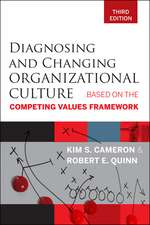The Power of People: FT Press Analytics
Autor Nigel Guenole, Jonathan Ferrar, Sheri Feinzigen Limba Engleză Hardback – 14 aug 2016
Business leaders today are seeking meaningful patterns in their people data that will help them gain a competitive edge. The answer is in the growing discipline of workforce analytics.
Much attention has already been paid to the technical requirements for implementing workforce analytics, now, there's a book that covers the organisational development and change management issues that will make or break your success.
Drawing on insights from dozens of experts in workforce analytics as well as their own cutting edge experience within IBM, the authors walk step-by-step through setting up and then embedding workforce analytics capabilities.
With candid case studies and clear advice from those who have already faced and overcome the challenges associated with workforce analytics, you'll learn how to:
- Begin with a vision, not data analysis
- Pick your projects wisely, so you can "earn your keep" with visible, valuable successes
- Build a team with the right skills to deliver the insights your organisation needs
- Identify the right stakeholders and sponsors to ensure success
- Choose the best technology for your analytics needs
- Handle some of the sensitivities around using employee data in analytics projects
- Run a successful workforce analytics function for the long term
- Use storytelling techniques to ensure you can influence organisational decisions or initiatives with the results of your workforce analytics projects
Analytics are rapidly becoming pervasive in functions ranging from Finance to Marketing. Now, discover how HR can gain just as much value, by informing every key decision with the best possible insight.
Preț: 145.86 lei
Nou
27.91€ • 29.14$ • 23.10£
Disponibil
Livrare economică 14-28 martie
Livrare express 27 februarie-05 martie pentru 26.80 lei
Specificații
ISBN-10: 0134546008
Pagini: 224
Dimensiuni: 152 x 229 x 20 mm
Greutate: 0.41 kg
Editura: Pearson FT Press
Seria FT Press Analytics
Notă biografică
Cuprins
Foreword by John Boudreau xv
About the Authors xix
Interviewees xxi
Vignettes xxv
Preface xxvii
PART I: UNDERSTANDING THE FUNDAMENTALS 1
Chapter 1 Why Workforce Analytics? 3
Adoption of Analytics 4
HR’s Contribution to Business Value 4
The Changing Nature of HR 7
The Future of Work 11
Summary 13
Chapter 2 What’s in a Name? 15
Focus of the Function 16
Activities of the Function 17
A Name Fit for the Future 18
Summary 18
Chapter 3 The Workforce Analytics Leader 19
Reporting to the Chief Human Resources Officer 20
Responsibilities of the Workforce Analytics Leader 20
Business Acumen 22
Leadership Attributes 23
Summary 26
Chapter 4 Purposeful Analytics 27
A Model for Purposeful Analytics 28
Project Sponsors 38
Why Do Analytics Projects Fail? 40
Summary 42
Chapter 5 Basics of Data Analysis 43
Research Design 44
Objectives of Analysis 47
Unstructured Data 52
Traditional Statistics versus Machine Learning 53
Social Consequences of Algorithms 54
More on Design and Analysis 56
Summary 56
Chapter 6 Case Studies 57
Eight-Step Methodology 58
Case Study: Improving Careers Through Retention Analytics at Nielsen 59
Case Study: From Employee Engagement to Profitability at ISS Group 65
Case Study: Growing Sales Using Workforce Analytics at Rentokil Initial 71
Case Study: Increasing Value to the Taxpayer at the Metropolitan Police 76
Case Study: Predictive Analytics Improves Employee Well-Being at Westpac 80
Summary 83
PART II: GETTING STARTED 85
Chapter 7 Set Your Direction 87
You Have the Job! Now What? 88
Listening to Prospective Project Sponsors 90
The Seven Forces of Demand 91
Agreeing on the Scope of Analytics 95
Developing a Vision and Mission Statement 95
Summary 97
Chapter 8 Engage with Stakeholders 99
Who Are Stakeholders? 100
Stakeholders Served 101
Stakeholders Depended Upon 106
Stakeholders Impacted 113
Working Effectively with Stakeholders 118
Summary 121
Chapter 9 Get a Quick Win 123
Identifying Potential Projects 125
Complexity-Impact Matrix 125
Assessing Complexity and Impact 129
Summary 133
PART III: BUILDING YOUR CAPABILITY 135
Chapter 10 Know Your Data 137
A Pragmatic View of Data 138
Solving Data Quality Challenges 138
Data Types and Sources 147
Data Governance 152
Remember the Basics 152
Summary 155
Chapter 11 Know Your Technology 157
Starting with Vision and Mission 158
Components of Workforce Analytics Technology 159
On-Premise Versus Cloud 164
Technology Vendor Relationships 165
Summary 167
Chapter 12 Build the Analytics Team 169
Six Skills for Success 170
Configuring Team Roles 181
Remember the Fundamentals! 184
Summary 185
Chapter 13 Partner for Skills 187
Why Consider Partners? 188
Options for Building the Team 188
Choosing Among the Options 197
Summary 200
Chapter 14 Establish an Operating Model 203
Defining Your Operating Model 204
Strategy 205
Governance 205
Implementation 212
Accountability 221
Summary 224
PART IV: ESTABLISHING AN ANALYTICS CULTURE 225
Chapter 15 Enable Analytical Thinking 227
Perspectives of Analytics in HR 228
The Translator Role 234
The Importance of Leadership 236
Summary 237
Chapter 16 Overcome Resistance 239
Resistance to Workforce Analytics 240
Stakeholder Skepticism 240
Financial Frugality 245
HR Hesitancy 246
Summary 252
Chapter 17 Communicate with Storytelling and Visualization 253
What Is Storytelling? 254
Effective Visualization 263
Knowing Your Audience 269
Keeping It Simple 273
Summary 275
Chapter 18 The Road Ahead 277
Analytics Provides New Opportunities for HR 278
Emerging Data Sources 278
Considering New Data Sources 280
Evolving Technology 282
The Workforce Analytics Function 283
Summary 286
Glossary 287
References 295
Index 301

























